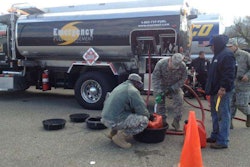In the wake of powerful Hurricane Sandy, Meritor today released the following technical bulletin providing fleets with suggested inspection and maintenance practices for vehicles exposed to contaminated flood waters:
Axles
Rear Drive and Front Drive Steer
Refer to Maintenance Manual 5A, Single-Reduction Differential Carriers Single Rear Drive Axles, Rear-Rear Tandem Drive Axles and Front Drive Steer Axles; Maintenance Manual 5L, Single-Reduction Forward Differential Carriers on Tandem and Tridem Axles; Maintenance Manual MM-0970, MT-14X Series Single-Reduction Forward Differential Carriers on Tandem Axles; and Maintenance Manual MM-0990, Amboid Rear Differential Carrier Rear/Rear Carrier on MT-40-14X Series Tandem Drive Axles.
1. Remove and completely disassemble the carrier assembly. Inspect all components for water and contaminant damage that includes, but is not limited to, rust and corrosion. Replace all damaged components.
2. Clean the housings to ensure that you remove all water and contaminants.
3. Replace all seals. Do not reuse seals. 4. Replace the breather assembly.
Front Non-Drive Steer
Refer to Maintenance Manual 2, Front Non-Drive Steer Axles/All Meritor Conventional, Easy Steer PlusTM and MFS Series.
1. Remove and completely disassemble the wheel end and steering knuckle assembly.
2. Inspect all components for water and contaminant damage that includes, but is not limited to, rust and corrosion. Replace all damaged components.
3. Replace all seals. Do not reuse seals.
Tie Rods
Inspection is not possible. Replace all tie rod ends.-ue1ec3dh0n15ic1a-1l B2ulletin
Trailer Axles
Refer to Maintenance Manual 14, Trailer Axles.
1. Inspect all components for water and contaminant damage that includes, but is not limited to, rust and corrosion. Replace all damaged components.
2. Remove the spindle end plugs. Drain any water that may have entered the axle tube cavity.
3. Blow air through the inside of the tube to clean and dry the tube cavity.
4. Replace the spindle end plugs.
Conventional (Non-Unitized) Hubs on Rear Drive, Front Drive Steer, Front Non-Drive Steer, and Trailer Axles
Refer to Maintenance Manual MM-0409, Wheel-End Components, Meritor Conventional and Unitized Wheel Ends.
Oil or Grease Lubricated; Conventional Bearings
1. Remove the hub from the spindle. Completely disassemble the hub assembly.
2. Inspect all components for water and contaminant damage that includes, but is not limited to, rust and corrosion. Replace all damaged components.
3. Clean the hubs to ensure that you have removed all water and contaminants.
4. Replace all seals. Do not reuse seals.
Unitized Hubs on Front Non-Drive Steer and Trailer Axles
Refer to Maintenance Manual MM-0409, Wheel-End Components, Meritor Conventional and Unitized Wheel Ends.
Sealed; Not Adjustable
1. Replace the hub unit as an assembly. Inspection is not possible.
2. Clean and inspect the spindles for water and contaminant damage that includes, but is not limited to, rust or corrosion before you install the new hub assembly. Replace damaged spindles.
Drivelines
Refer to Maintenance Manual MM-96147, Drivelines; Maintenance Manual MM-0998, Xtended Lube MXLTM 17N, 176N and 18N Series Drivelines.
RPL PermalubeTM Series Permanently-Lubricated; MXLTM Greaseable Universal Joints and Slip Yokes
1. Replace all universal joints and center bearings. Inspection is not possible.
2. Completely disassemble and inspect the slip assembly. Inspect all components for water and contaminant damage that includes, but is not limited to, rust and corrosion.
3. Replace all damaged components.
Transfer Cases
Refer to Maintenance Manual MM-0146, Transfer Cases, MTC-4208, -4210 and -4213; and Maintenance Manual MM-0861, Transfer Cases, MTC-4208X/XL/XP, MTC-4210X/XL/XP and MTC-4213X Series.
1. Remove and completely disassemble the transfer case assembly.
2. Clean the housing to ensure that you have removed all water and contaminants.
3. Inspect all components for water and contaminant damage that includes, but is not limited to, rust and corrosion. Replace all damaged components.
4. Replace the breather assembly.
5. Replace all seals. Do not reuse seals.
Air-Actuated Cam, Disc and Wedge Brakes (All Models)
Refer to Maintenance Manual 4, Cam Brakes and Automatic Slack Adjusters; and Maintenance Manual 4R, Wedge Brakes; MM-0467, DiscPlusTM EX225 Air Disc Brake.
1. Completely disassemble the brake assembly. You don’t have to remove the brake spider or torque plate. Inspect all components for water and contaminant damage that includes, but is not limited to, rust and corrosion. Replace all damaged components.
2. Clean all components and housings to ensure that you remove all contaminants. Ensure that all sliding surfaces, such as caliper slide pins, camshafts, etc., are free of rust and contaminants.
3. Replace all shoes and linings (pads).
4. Replace the seals. Do not reuse seals.
5. Lubricate the brake assembly completely to purge all residual contaminants.
6. Contact the brake chamber manufacturer for instructions to verify what should be inspected or replaced before returning the vehicle to service.
Automatic Slack Adjuster
Refer to Maintenance Manual 4, Cam Brakes and Automatic Slack Adjusters.
1. Replace the complete slack adjuster assembly.
2. Clean and lubricate the clevis pin.
Hydraulic-Actuated Drum and Disc Brakes
1. Completely disassemble the brake assembly. You don’t have to remove the torque plate or brake spider. Inspect all components for water and contaminant damage that includes, but is not limited to, rust and corrosion. Replace all damaged components.
2. Clean all components and housings to ensure that you remove all contaminants. Ensure that all sliding surfaces, such as caliper slide pins, camshafts, etc., are free of rust and contaminants.
3. Replace all shoes and linings (pads).
4. Replace all seals. Do not reuse seals.
Brake Drums and Rotors
Refer to Maintenance Manual MM-0409, Wheel-End Components, Meritor Conventional and Unitized Wheel Ends.
1. Remove and inspect the brake drums and rotors for water and contaminant damage that includes, but is not limited to, rust and corrosion.
If you find rust on the braking surface: Remove it with a light emery cloth.
2. Thoroughly clean all surfaces, including all debris on the rotor cooling vanes.
3. Clean and remove all contaminants from all ABS tooth wheel surfaces, as well as the air gaps between the teeth.
Shock Absorbers
Replace all shock absorbers.
RideStar RHP Series Trailer Air Suspension Systems
Refer to Maintenance Manual 14S, RideStar RHP Series Sliding Tandem Trailer Air Suspension System.
1. Remove and replace the suspension pivot bushings.
2. Inspect all components for water and contaminant damage that includes, but is not limited to, rust and corrosion.
3. Clean the components before installing new bushings.
4. Replace all rubber parts. Replace all air springs.
5. Replace all shock absorbers.
Slider Pin Mechanism
1. Pull and release the slider pull handle several times.
2. Check to ensure that all four locking pins retract and engage freely, and that no binding or excessive corrosion is present on the linkage system.
If the system does not operate freely or excessive corrosion is present: Clean and lubricate the linkage connection points. Continue to pull and release the locking system until all pins retract and engage freely.
RideStar RFS Series Trailer Air Suspension System
Refer to Maintenance Manual 14F, RideStar Trailer Air Suspension Systems, RFS Series.
1. Remove and replace the suspension pivot bushings.
2. Inspect all components for water and contaminant damage that includes, but is not limited to, rust and corrosion.
3. Clean the components before installing new bushings.
4. Replace all air springs. Replace all rubber parts.
5. Replace all shock absorbers.
Height Control Valve
1. Remove and replace the height control valve.
2. Ensure the air system is clean and dry.
3. Set the ride height. Refer to the manufacturer’s specifications.
RideSentry MPA Series Trailer Air Suspension Systems
Refer to Maintenance Manual 14R, RideSentry MPA Series Sliding Tandem Trailer Air Suspension System.
1. Remove and replace the suspension pivot bushings.
2. Inspect all components for water and contaminant damage that includes, but is not limited to, rust and corrosion.
3. Clean the components before installing new bushings.
4. Replace all rubber parts. Replace all air springs.
5. Replace all shock absorbers.
Slider Pin Mechanism
1.Disassemble and replace the pin control valve and slider pin actuation chamber.
2. Ensure the air system is clean and dry.
3. Set the trailer brakes. Release and engage the lock pins several times.
4. Check to ensure that all four locking pins retract and engage freely, and that no binding or excessive corrosion is present on the complete pin system.
If the system does not operate freely or excessive corrosion is present: Clean and lubricate the linkage connection points. Continue to pull and release the locking system until all pins retract and engage freely.
Meritor MTA Series Trailer Air Suspension System
Refer to Maintenance Manual 14M, Meritor MTA Series Trailer Air Suspension Systems.
1. Remove and replace the suspension pivot bushings.
2. Inspect all components for water and contaminant damage that includes, but is not limited to, rust and corrosion.
3. Clean the components before installing new bushings.
4. Replace all air springs. Replace all rubber parts.
5. Replace all shock absorbers.
Height Control Valve
1. Remove and replace the height control valve.
2. Ensure the air system is clean and dry.
3. Set the ride height. Refer to the manufacturer’s specifications.
Meritor Tire Inflation Systems (MTIS) by P.S.I.TM
Refer to Maintenance Manual 14P, Meritor Tire Inflation Systems (MTIS) by P.S.I., Standard MTIS, MTIS with the ThermALERT Systems.
1. Disassemble air hoses from the control box to the axle. Ensure they are clean and dry.
2. Disassemble the tire stem hoses from the “T” in the hubcap. Inspect the “T” for water and contaminant damage that includes, but is not limited to, rust and corrosion. Replace all damaged “Ts”.
3. Inspect the hubcaps for water and contaminant damage that includes, but is not limited to, rust and corrosion. Replace all damaged hubcaps.
4. Inspect all hoses for water and contaminant damage that includes, but is not limited to, rust and corrosion. Replace all damaged hoses.
5. Remove the hubs. Remove the stators from the axle plugs. Inspect the stators for water and contaminant damage that includes, but is not limited to, rust and corrosion. Replace all damaged stators. If the stators are not damaged, clean and dry them for possible reuse.
6. Remove the axle spindle end plugs. Drain all water that may have entered the axle tube cavity. Blow air through the inside of the tube to clean and dry the tube cavity.
7. Install new spindle plugs and install the stators.
8. Replace the MTIS control box and indicator light on the front of the trailer.
9. Ensure the system is operating correctly before returning the vehicle to service.











